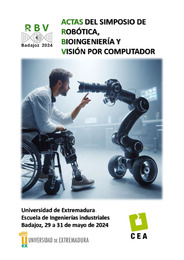Please use this identifier to cite or link to this item:
https://hdl.handle.net/11000/32892Full metadata record
| DC Field | Value | Language |
|---|---|---|
| dc.contributor.author | Máximo, Miriam | - |
| dc.contributor.author | Ballesta, Mónica | - |
| dc.contributor.author | Heredia-Aguado, Enrique | - |
| dc.contributor.author | Valiente, D. | - |
| dc.contributor.author | Reinoso, Oscar | - |
| dc.contributor.other | Departamentos de la UMH::Ingeniería de Sistemas y Automática | es_ES |
| dc.date.accessioned | 2024-09-02T10:38:28Z | - |
| dc.date.available | 2024-09-02T10:38:28Z | - |
| dc.date.created | 2024 | - |
| dc.identifier.citation | Actas del Simposio de Robótica, Bioingeniería y Visión por Computador, Badajoz, 29-31 de mayo de 2024 | es_ES |
| dc.identifier.isbn | 978-84-9127-262-5 | - |
| dc.identifier.uri | https://hdl.handle.net/11000/32892 | - |
| dc.description.abstract | La búsqueda de la ubicación de un robot es un aspecto clave dentro del campo de la robótica móvil. Un método que utiliza información de los sensores para determinar la pose del robot en entornos conocidos previamente es el método de localización Monte Carlo. En este estudio se ha utilizado una variante topológica del mismo, en el cual el objetivo es encontrar la posición del robot en el instante actual dentro de los nodos del mapa topol´ogico. La información utilizada para la localización se obtiene de un sensor LiDAR, el cual realiza capturas de nubes de puntos que proporcionan información 3D del entorno. La informacíón más característica de estas nubes de puntos es extraída y convertida a un descriptor obtenido mediante técnicas de aprendizaje profundo. Se han usado dos bases de datos diferentes para analizar cómo se comporta el algoritmo en entornos con características diferentes. Los resultados obtenidos, incluyendo error y tiempo de computación, demuestran la robustez del método. | es_ES |
| dc.description.abstract | Finding the location of a robot is a key aspect in the field of mobile robotics. One method that uses sensor information to determine the robot’s pose in previously known environments is the Monte Carlo localization method. In this study, a topological variant of this method has been used, in which the objective is to find the position of the robot at the current instant within the nodes of the topological map. The information used for localization is obtained from a LiDAR sensor, which captures point clouds that provide 3D information about the environment. The most characteristic information of these point clouds is extracted and converted to a descriptor obtained by deep learning techniques. Two di↵erent databases have been used to analyse how the algorithm behaves in environments with di↵erent characteristics. The results obtained, including the error and computation time, demonstrate the robustness of the method. | es_ES |
| dc.format | application/pdf | es_ES |
| dc.format.extent | 15 | es_ES |
| dc.language.iso | spa | es_ES |
| dc.publisher | Universidad de Extremadura | es_ES |
| dc.relation.ispartof | Simposio de Robótica, Bioingeniería y Visión por Computador | es_ES |
| dc.rights | info:eu-repo/semantics/openAccess | es_ES |
| dc.rights.uri | http://creativecommons.org/licenses/by-nc-nd/4.0/ | * |
| dc.subject | localización Monte Carlo | es_ES |
| dc.subject | robótica móvil | es_ES |
| dc.subject | LiDAR | es_ES |
| dc.subject | nubes de puntos | es_ES |
| dc.subject.other | CDU::6 - Ciencias aplicadas::62 - Ingeniería. Tecnología | es_ES |
| dc.title | Localización topológica Monte Carlo basada en descripción de nubes de puntos LiDAR 3D | es_ES |
| dc.type | info:eu-repo/semantics/conferenceObject | es_ES |

View/Open:
actas Simposio Badajoz 2024 - mmaximo.pdf
1,12 MB
Adobe PDF
Share:
.png)
